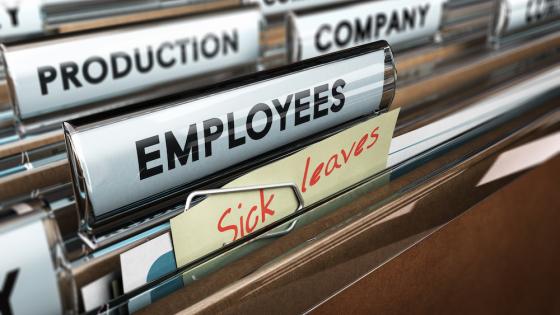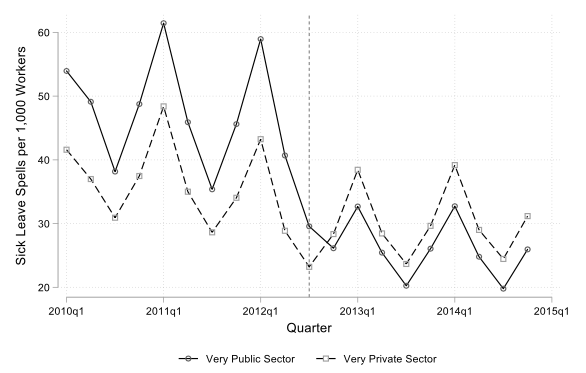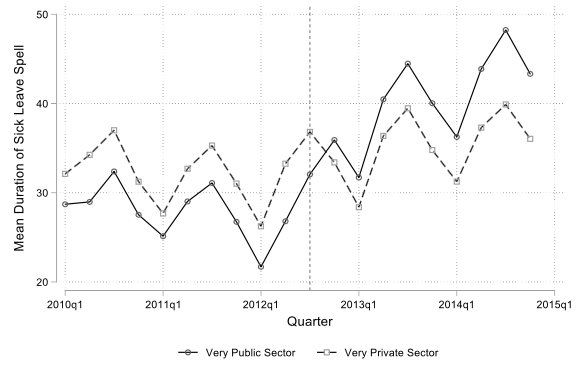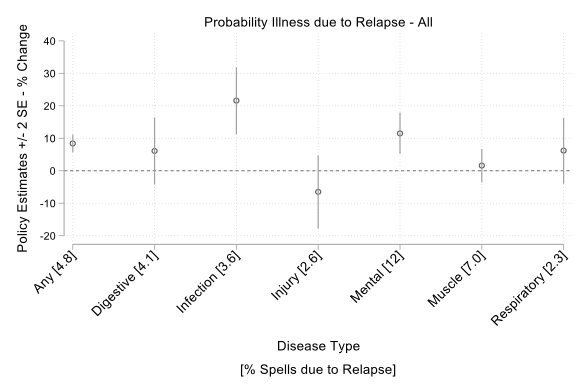Sick leave benefits aim to guarantee an individual’s right to be absent from work when ill while simultaneously incentivising returning as early as possible without putting their own or others’ health at risk.
In the past decade, many European countries have been reducing access and generosity of established schemes as they implement budgetary restrictions following the financial crisis. Some US cities, in contrast, have been tentatively introducing the right to paid sick leave after recent failures to implement such at the federal level (Pichler and Ziebarth 2020).
The current COVID-19 pandemic has drastically changed this configuration and brought critical urgency to our need to understand how to design optimal sick-leave benefits. In COVID-19’s wake, many countries rushed to implement emergency measures to pay people’s wages while they stayed home sick or were sheltering to avoid getting sick at work.
Certain European countries, for example, relaxed conditions to access public sick leave benefits in order to reduce infection rates. In some cases, workers could get paid absences automatically certified and granted over the phone.
In the US, where a comprehensive public sick-leave programme was not in place before the outbreak, the policy change was radical. Employee paid sick leave was introduced at the federal level in March 2020. It was among a package of legislative measures passed to address the economic consequences of the COVID-19 pandemic, under the Families First Coronavirus Response Act (FFCRA).1
These new policies are all meant to be temporary and to be scaled down or altogether scrapped as the pandemic subsides. The new benefits will, for example, expire at the end of 2020. When paid sick leave suddenly decreases at the end of the year, workers will be strongly incentivised to return to work. However, this transition needs to be handled in a manner that minimises risk to one’s own health and also to that of others, especially in the context of the potential persistence (or resurgence) of a highly infectious disease.
Although reducing the generosity of sick-leave benefits may limit the moral hazard of employees taking unnecessary absences, the overall positive effect could be severely mitigated if such reductions push some workers to go back to work while still sick or to find alternative ways to not return.
In a recent paper (Marie and Vall Castelló 2020), we investigate the impact on work absences of a very large cut in sick-leave benefits among Spanish public-sector employees, but which did not affect private-sector employees. We exploit the policy change and use new administrative data to estimate the direct causal effect of reducing paid sick leave on absences. We also examine its effect on premature returns to work, as measured by relapses or displacement towards other benefits.
The direct effect of cutting sick-leave benefits on work absences
In August 2012, the Spanish government radically changed the generosity of paid sick leave available to public-sector employees. It went from fully covering any lost wages for up to six months to a much lower replacement rate that gradually increased by the duration of sick leave (i.e. 50% for the first 3 days, 75% for 4-20 days, and 100% thereafter). This reform did not affect private-sector workers, allowing us to use these non-treated employees as a comparison group in a difference-in-difference setting.
We obtained social-security register data on employer-declared sick leave spells – both number and length – with exact health diagnostics for all individuals working in Spain between 2010 and 2014. All workers in our context are subject to the same tight monitoring system throughout this period, which makes it possible for us to estimate the policy’s pure income effect (i.e. net of the effect on changes in absences that monitoring or strictness of access might have had).
From official statistics, we also obtain the number of employees per sector to account for how many individuals are eligible for sick leave among the treated and control groups throughout this period. Workers were facing a tightening labour market at the time, but we show that this was equally true for private- and public-sector employees.
We then estimate how the reform affected both the sick-leave incidence rate (extensive margin) and the average spell duration (intensive margin). The main measure of the overall policy effect on absences is obtained by the interaction of these two margins to give us the total number of days lost to sick leave per worker each quarter.
Up to the introduction of the reform in autumn 2012, sickness absence rates of both private- and public-sector employees followed very similar (seasonal) trends, with the latter taking, on average, sick leave more often than the former. However, following the policy change, there was a marked drop in the number of sick-leave spells taken by public-sector workers. We estimate a 29% decrease in the sick-leave rate as a result of the reduction in benefit generosity.
Figure 1 Effect of reducing sick leave on number of spells taken
Notes: Own elaboration with administrative Spanish Social Security data, which includes the universe of sickness absences in Spain from 2010 until 2014, and data from the Spanish Labour Force Survey on the number of employed workers in each quarter and sector for the same period. The vertical dashed line indicates the quarter of policy introduction. ‘Very public sector’ includes workers in an activity group in which more than 95% of the workers are public employees (treated group). ‘Very private sector’ includes workers in an activity in which less than 5% of the workers are public employees (control group).
When considering changes in the duration of each sick-leave spell, the picture is almost perfectly reversed. The average length of each spell has a very similar trend for public- and private-sector employees up to the policy change, followed by a sharp 28% increase for treated workers (Figure 2).
Figure 2 Effect of reducing sick leave on average spell duration
Notes: Own elaboration with administrative Spanish Social Security data, which includes the universe of sickness absences in Spain from 2010 until 2014, and data from the Spanish Labour Force Survey on the number of employed workers in each quarter and sector for the same period. The vertical dashed line indicates the quarter of policy introduction. ‘Very public sector’ includes workers in an activity group in which more than 95% of the workers are public employees (treated group). ‘Very private sector’ includes workers in an activity in which less than 5% of the workers are public employees (control group).
This increased duration is not surprising: the change in the level of generosity was severest for shorter leaves, thus imposing large costs from returning to work after passing the 21-day threshold.
In terms of the total number of days lost, the reform led to a significant reduction in absenteeism, which we estimate to be about 10%. We further investigate heterogeneities in absence reduction by health condition and find that it is most important for three types of diseases: respiratory, infectious, and muscle-related illnesses.
Indirect effects on health relapses and benefit displacements
These direct policy effects on work absences are only part of the story. To obtain a more complete picture of its efficiency, we also consider potential externalities generated if – as a result of the increased cost from being sick – returns to work were premature.
We propose two new ways of measuring the policy’s effect on ‘presenteeism’ (i.e. being present at work while sick): changes in the probability of relapses and displacement towards (health-related) working accidents.
Figure 3 presents evidence on the changes in the proportion of relapses (i.e. being absent from work because of a disease that had been diagnosed during a previous sick-leave spell and from which the individual had not completely recuperated) by worker type. We find clear evidence of a large increase in the proportion of relapses after the policy change that is only present for public-sector employees.
Figure 3 Effect of reducing sick leave on relapse probability
Notes: Own elaboration with administrative Spanish Social Security data, which includes the universe of sickness absences in Spain from 2010 until 2014, and data from the Spanish Labour Force Survey on the number of employed workers in each quarter and sector for the same period. The vertical dashed line indicates the quarter of policy introduction. ‘Very public sector’ includes workers in an activity group in which more than 95% of the workers are public employees (treated group). ‘Very private sector’ includes workers in an activity in which less than 5% of the workers are public employees (control group).
This change was especially strong for short sick-leave spells, on which the policy change had the largest effect in terms of absence reduction. By disease type, we find that the change in relapse probability is mostly driven by an increase in infectious diseases relapses (Figure 4).
Figure 4 Effect of reducing sick leave on relapse by disease type
Notes: Own elaboration with administrative Spanish Social Security data, which includes the universe of sickness absences in Spain from 2010 until 2014, and data from the Spanish Labour Force Survey on the number of employed workers in each quarter and sector for the same period. The vertical dashed line indicates the quarter of policy introduction. ‘Very public sector’ includes workers in an activity group in which more than 95% of the workers are public employees (treated group). ‘Very private sector’ includes workers in an activity in which less than 5% of the workers are public employees (control group).
This finding is especially worrisome given the strong likelihood that a worker would further spread such contagious diseases to others in the workplace if they return before being properly cured.
Next, we investigate the possibility that workers affected by costlier sick leave may more often make use of a benefits scheme that was unaffected by the policy change, namely, working accidents.
Our results reveal that absences due to work-related accidents increased by over 50% for public-sector workers when sick-leave generosity was curtailed. Most of the accidents are related to ‘back pain’ complaints – a category that experienced large drops for both long-term sick leave and relapses. We interpret this as a persuasive indication that cross-benefit displacement is at play here.
While this had been documented for other benefits (Petrongolo 2009 or Borghans et al. 2014), our study is the first to show that cross-benefit displacement is such an important issue for paid sick leave. Taking the displacement effect into account reduces the direct effect of the policy change – that was estimated based on absences alone – by almost two-fifths, showing how crucial it is to take displacement into account when evaluating any benefit reforms.
The substantial negative spillover effects of cutting sick-leave generosity should be taken into account when deciding how and when to curtail workers’ benefits in the future. Too much too soon and the costs could be high.
References
Borghans, L, E F P Luttmer and A Gielen (2014), “Social support substitution and the earnings rebound: Evidence from a regression discontinuity in disability insurance reform”, American Economic Journal: Economic Policy 6(4): 34–70.
Marie, O, and J Vall Castelló (2020), “If sick-leave becomes more costly, will I go back to work and could it be too soon?”, CEPR Discussion Paper 14899.
Petrongolo, B (2009), “The long-term effects of job search requirements: Evidence from the UK JSA reform”, Journal of Public Economics 93: 1234–53.
Pichler, S, and N Ziebarth (2020), “Labor market effects of US sick pay mandates”, Journal of Human Resources 55(2): 611–59.
Endnotes
1 For more details on the FFCRA, see here.








